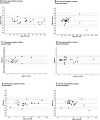The interrater and test-retest reliability of 3 modalities of quantitative sensory testing in healthy adults and people with chronic low back pain or rheumatoid arthritis
- PMID: 37829138
- PMCID: PMC10566868
- DOI: 10.1097/PR9.0000000000001102
The interrater and test-retest reliability of 3 modalities of quantitative sensory testing in healthy adults and people with chronic low back pain or rheumatoid arthritis
Abstract
Introduction: Quantitative Sensory Testing (QST) modalities used to assess central pain mechanisms require different protocols in people with different musculoskeletal conditions.
Objectives: We aimed to explore the possible effects of musculoskeletal diagnosis and test site on QST interrater and test-retest reliability.
Methods: The study included participants with rheumatoid arthritis (RA, n = 18; QST conducted on lower leg) and low back pain (LBP, n = 25; QST conducted on forearm), plus 45 healthy control participants (n = 20 QST on lower leg and n = 25 QST on forearm). Test-retest reliability was assessed from QST conducted 1 to 3 weeks apart. Quantitative sensory testing modalities used were pressure pain detection threshold (PPT) at a site distant to tissue pathology, temporal summation (TS), and conditioned pain modulation (CPM). Temporal summation was calculated as difference or ratio of single and repeated punctate stimuli and unconditioned thresholds for CPM used single or mean of multiple PPTs. Intraclass correlation coefficients (ICCs) were compared between different subgroups.
Results: High to very high reliability was found for all assessments of PPT and TS across anatomical sites (lower leg and forearm) and participants (healthy, RA, and LBP) (ICC ≥ 0.77 for PPT and ICC ≥ 0.76 for TS). Reliability was higher when TS was calculated as a difference rather than a ratio. Conditioned pain modulation showed no to moderate reliability (ICC = 0.01-0.64) that was similar between leg or forearm, and between healthy people and those with RA or LBP.
Conclusion: PPT and TS are transferable tools to quantify pain sensitivity at different testing sites in different musculoskeletal diagnoses. Low apparent reliability of CPM protocols might indicate minute-to-minute dynamic pain modulation.
Keywords: Low back pain; Quantitative sensory testing; Reliability; Rheumatoid arthritis.
Copyright © 2023 The Author(s). Published by Wolters Kluwer Health, Inc. on behalf of The International Association for the Study of Pain.
Conflict of interest statement
D.F.M. has grant support from Eli Lilly and Pfizer for projects outside of this study. D.A.W. has grant support from Eli Lilly, UCB and Pfizer for projects outside of this study. Consultancies for Pfizer, AbbVie, GSK. No other potential conflicts were declared by other authors.Sponsorships or competing interests that may be relevant to content are disclosed at the end of this article.
Figures



References
-
- Arendt-Nielsen L, Yarnitsky D. Experimental and clinical applications of quantitative sensory testing applied to skin, muscles and viscera. J Pain 2009;10:556–72. - PubMed
-
- Arendt‐Nielsen L, Morlion B, Perrot S, Dahan A, Dickenson A, Kress HG, Wells C, Bouhassira D, Drewes AM. Assessment and manifestation of central sensitisation across different chronic pain conditions. Eur J Pain 2018;22:216–41. - PubMed
-
- Arifin WN. Sample size calculator (web) [Internet]. 2023 Available at: http://wnarifin.github.io
-
- Bartlett MS. The use of transformations. Biometrics 1947;3:39–52. - PubMed
-
- Bisset LM, Evans K, Tuttle N. Reliability of 2 protocols for assessing pressure pain threshold in healthy young adults. J Manipulative Physiol Ther 2015;38:282–7. - PubMed
LinkOut - more resources
Full Text Sources
Miscellaneous
